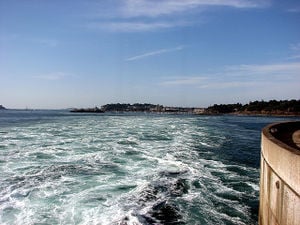
Tidal Power: Using specially designed turbines to generate power through the movement and energy of the tides.
Tidal power is only viable in coastal perimeter areas where the current speeds exceed 1.2 meters per second, however most current speeds throughout the ocean do not exceed 0.1 meters per second.[1] Viable speeds for turbine energy production occur in few spots around the world. The only areas where high current speeds are possible are areas of turbulent seas where currents are pushed through channels between land masses. Some such places are the Orkney Islands north of Scotland, the northern coast of Australia, and the Bay of Fundy in Nova Scotia.
However, there is some controversy over installing tidal farms in these areas because of the rich marine ecosystems that prosper from the high current speeds. Many of these areas are breeding grounds for marine life because the nutrients spread by the high currents strongly benefit oceanic species. If such tidal turbine farms were installed in these areas they have the potential to disrupt marine life by throwing off certain currents and killing fish that pass through them. Turbines kill 80% of fish that come into contact with them.[2]
Planning and development of these tidal energy farms is extremely costly. A Reynolds Averaged Navier Stokes equation can be computed to figure out proper placement of the turbines on the sea floor but this operation is extremely expensive and small time developments cannot afford to do this.[3]
Metal turbines do not generally fare well under the ocean because fatigue caused by the currents and salinity have large strains on metal. Installation of these turbines can also cost millions of dollars and retrieval for maintenance can be just as costly.[4]
Wave Energy[edit | edit source]
There are many different ways of harnessing energy from the ocean here are a few that use the power of the waves to do so. Tidal Barrage is a mechanism that dams of a bay on the coastline of the ocean, this machines captures high tide water in the bay and then releases it during low tide when the ocean water is at a lower point. As the water moves out of the bay it spins turbines which then generate electricity from this movement.
Pelamis Wave Energy[edit | edit source]
The Pelamis is essentially a huge floating cylindrical mechanism that is broken up into sections, joined together by hinged joints. As a wave passes down the machine these hinges flex but are resisted by hydraulic pumps. These pumps pump oil into a turbine which then in turn creates electricity. There are three of these off the coast of Portugal that feed energy to 1500 homes back on the mainland.
Wave Treader[edit | edit source]
This device is essentially a buoy with two arms on each side, as waves pass by the arms move up and down, this motion is harvested by hydraulic cylinders that generate electricity. The electricity produces is then carried off to the shore via underwater cable lines.
Biowave[edit | edit source]
This is another mechanism to harvest energy from the waves. This device is mounted to the seafloor in shallow water with a structure that holds three buoys what move up and down as waves pass by. The up and down movement of the buoys generate the energy which converts mechanical energy into fluid pressure which spins a generator. Demonstrations videos
- http://www.youtube.com/watch?v=snxm1EaDf4g (Biowave)
- http://www.youtube.com/watch?v=F0mzrbfzUpM&feature=related (Pelamis)
- http://www.youtube.com/watch?v=tSBACzRE3Gw (Tide power)
References[edit | edit source]
- ↑ van Haren, Hans. "Tidal Power? No Thanks." New Scientist 205.2754 (2010): 20-21. Academic Search Premier. Web. 7 Dec. 2011.
- ↑ van Haren, Hans. "Tidal Power? No Thanks." New Scientist 205.2754 (2010): 20-21. Academic Search Premier. Web. 7 Dec. 2011.
- ↑ Ye, Li, and Sander M. Calisal. "Estimating Power Output From A Tidal Current Turbine Farm With First-Order Approximation Of Hydrodynamic Interaction Between Turbines." International Journal Of Green Energy 7.2 (2010): 153-163. Environment Complete. Web. 7 Dec. 2011.
- ↑ Pearce, Fred. "Rising Tide." New Scientist 211.2830 (2011): 48-51. Academic Search Premier. Web. 7 Dec. 2011.